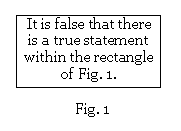
“According to [Bertrand] Russell’s treatment the sentence within the rectangle of Fig. 1 is meaningless, and may be called a pseudo-statement, because it is a version of the liar-paradox. But Russell’s treatment is unsatisfactory because it resolves the original paradox at the price of a new one. For, if the sentence of Fig. 1 is meaningless we must admit, since we observe that there are no other sentences within the rectangle, that it is false that there is a genuine or meaningful statement within the rectangle of Fig. 1. And, if there is no statement within the rectangle of Fig. 1 then it is false that there is a true statement within the rectangle of Fig. 1. The italicized part of the preceding sentence will be recognized as identical with (even if a different token of) the sentence within the rectangle of Fig. 1. And since the italicized sentence is true, and therefore a meaningful statement, the sentence within the rectangle is not a pseudo-statement either. Thus, if the sentence in question is meaningless, then it is meaningful and vice versa.”
— A.P. Ushenko, “A Note on the Liar Paradox,” Mind, October 1955
